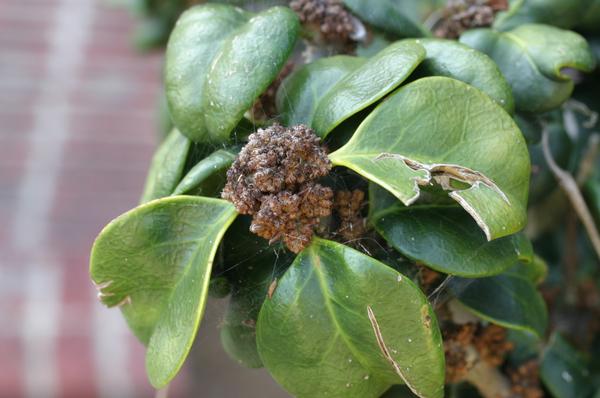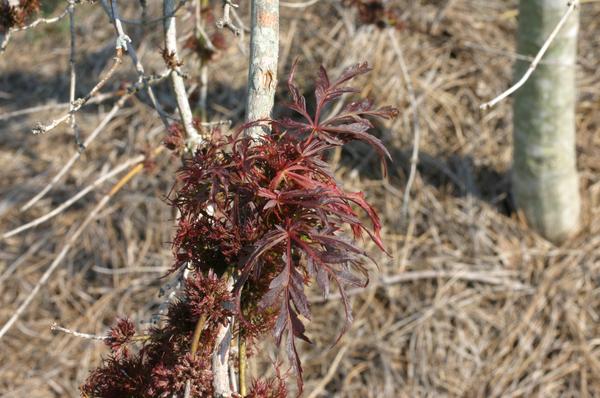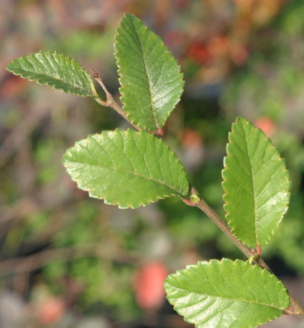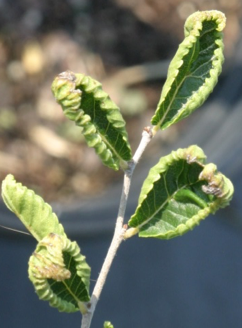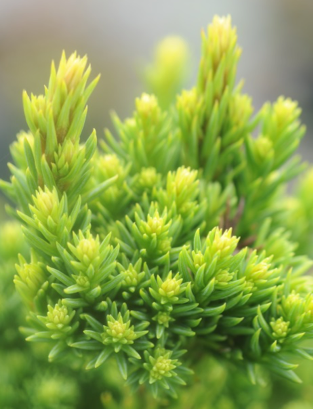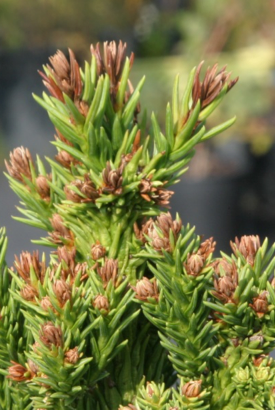Problem
Herbicide injury from ALS inhibitors including imidazolinones (such as imazapic, imazapyr and several others) and sulfonylureas (including sulfosulfuron, metsulfuron, sulmetron, and others).
Symptoms
- Yellow shoot tips and die-back.
- Yellow, pink or purple veins.
- Shorter internodes.
- “Bottle brushing” roots.
- In woody plants, ALS inhibitors may cause:
- foliar cupping.
- deformed foliage.
- witches brooms.
- general die-bac.

Knockout rose chlorosis caused by imazapyr spray drift, two weeks after application.
B. Lassiter CC BY-NC-SA 4.0

Reddish pigmentation of main veins on strawberry caused by imazapyr spray drift, five days after treatment.
B. Lassiter CC BY-NC-SA 4.0

Crape myrtle: imazapyr, soil applied, stunted with new growth witches broom.
J. Neal CC BY-NC-SA 4.0

Crape myrtle: imazapyr, soil applied, stunted with new growth witches broom.
J. Neal CC BY-NC-SA 4.0

Arborvitae: imazapic, soil applied, plant severely stunted, chlorotic and necrotic growing points.
J. Neal CC BY-NC-SA 4.0

Arborvitae: imazapic spray drift; tip necrosis, stunted and chlorotic growing points, new needles curled back.
J. Neal CC BY-NC-SA 4.0

Imazapic spray drift on loropetalum. Initial symptoms about two weeks after treatment include stunted and chloratic new growth. Treated foliage on the left, non-treated on the right. Over time tip necrosis, witches broom, and dieback develop.
J. Neal CC BY-NC-SA 4.0

Imazapic spray drift on hydrangea, about two weeks after treatment. Initial symptoms include stunting and chlorotic new growth. Treated foliage on the left, non-treated on the right.
J. Neal CC BY-NC-SA 4.0
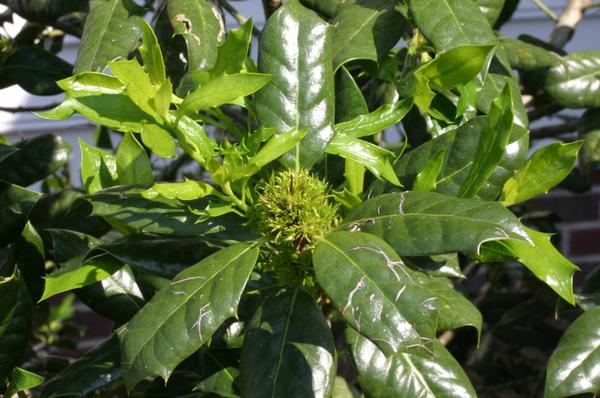
Imazapyr root uptake injury to Nellie R Stevens Holly. Applied as a mixture of glyphosate + imazapyr to weeds around the plant.
J. Neal CC BY-NC-SA 4.0
Plant Entry and Symptom Expression
Foliar and soil absorbed and translocated. Some ALS herbicides have long residual and may affect nearby plants via root uptake or crops planted into previously treated soils. Selected ALS members provide very broad spectrum control while others are quite narrow. Growth cessation within a week of application, followed by chlorosis of the growing points, then tip necrosis, followed by a general decline and death over a period of 3 to 4 weeks. ALS-resistant crops are widely used.
Similar Problems
ALS inhibitor injury may be confused with symptoms from:
- Glyphosate.
- Desiccation – loss of cell turgor pressure; salt accumulation.
- General root decline due to poor soil conditions or soil diseases.
- In woody plants, witches brooms and deformed or cupped foliage may resemble glyphosate drift or auxin herbicide injury.
Herbicide Mode of Action Category
WSSA – 2
HRAC – B
Useful Resources
North Carolina Agricultural Chemicals Manual
Southern Region Small Fruit Consortium
Southeastern US Vegetable Crop Handbook
Weed Management in Nurseries, Landscapes & Christmas Trees Information Portal
Herbicide Handbook, Weed Science Society of America
Applied Weed Science: Including the Ecology and Management of Invasive Plants (3rd Edition), Merrill Ross & Carol Lembi, pages 166, 172-173, 175, 242, 246-248
Publication date: Dec. 14, 2015
Reviewed/Revised: Feb. 13, 2024
N.C. Cooperative Extension prohibits discrimination and harassment regardless of age, color, disability, family and marital status, gender identity, national origin, political beliefs, race, religion, sex (including pregnancy), sexual orientation and veteran status.

